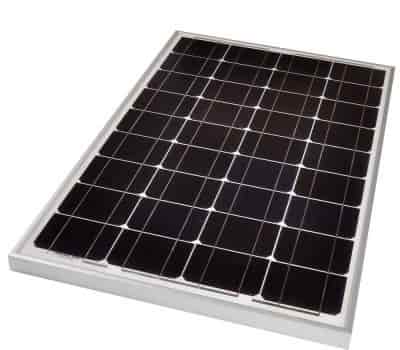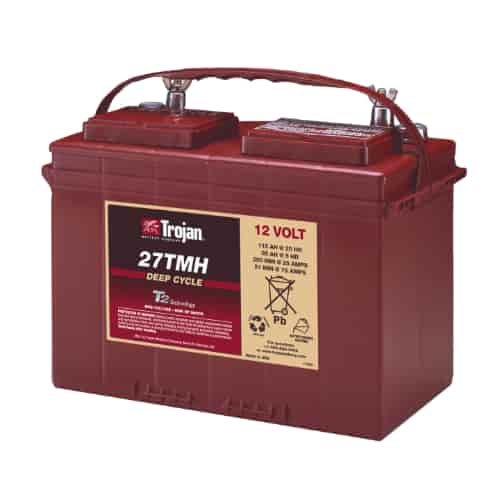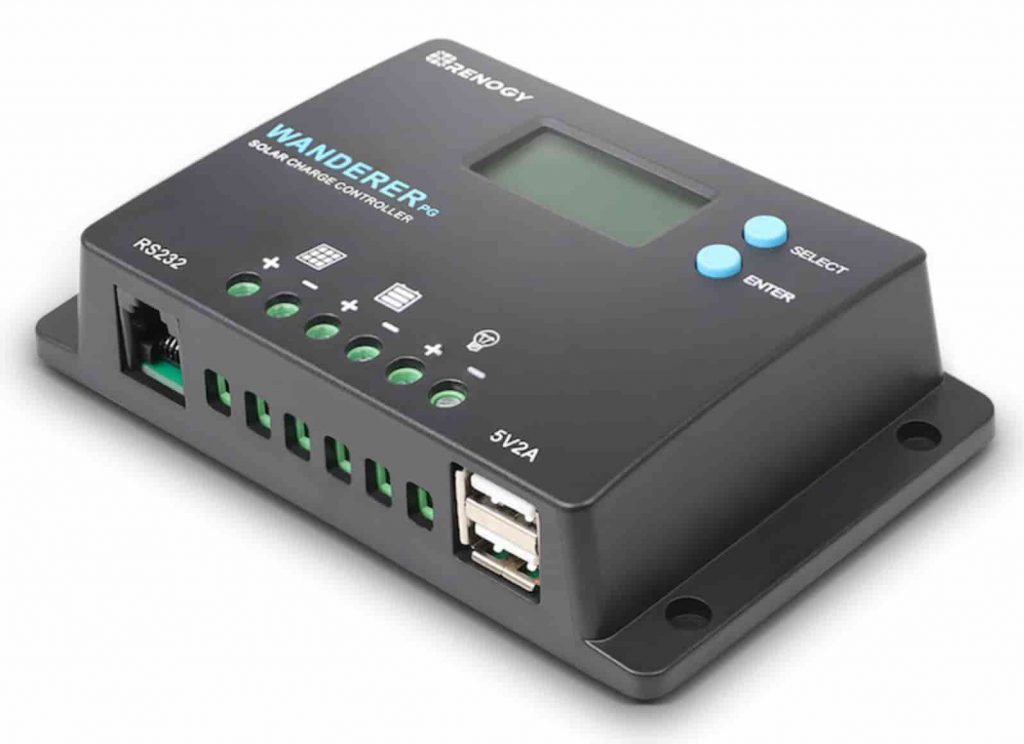Choosing the right size solar panel and battery
In my various jobs and businesses, I have often been asked to help people choose the right size of solar panel and battery for a low power device (lights, compost toilet fans, USB chargers…). In many cases, it’s been to power the fan in an off-grid compost toilet (although my methods and maths applies to anything that could use electricity, such as a lights and USB sockets).
The main difference between compost toilet fans and other electrical stuff like light bulbs, is that the fan tends to be running 24-hours a day. In some ways, it makes it easier to do the calculations because you know it’s on all the time, whereas a bulb is only on for a relatively short amount of time (perhaps longer in the winter when the nights are longer).
But what size solar panel and battery will be right for you? Here, I’ll explain how I work out the ideal size panel and battery capacity.
It’s easy to under-specify both the panel size and battery. Whilst the system may work well from March to October, winter puts additional pressure on the battery and an under-sized solar panel can dramatically shorten battery life expectancy, leading to an unexpected loss of power and the expense of having to replace a battery! Relatively speaking, solar panels are not that expensive, so it’s best to err on the side of caution and go bigger than you need.
What size solar panel will you need?

The 12-volt fans in many compost toilets, draw between 1 and 2.5 watts at 12 volts DC depending on the make and model (check with your supplier if you haven’t bought it yet, or look at the fan itself for information).
Because they run 24 hours a day, you take the power requirement (for example 2.5 watts) and multiply this by 24 (the hours in a day) and you get a daily power requirement of 60 watt-hours (for a 2.5-watt fan).
A 20-watt solar panel, operating at 100% efficiency (i.e. assuming the sun is shining brightly and directly onto your solar panel with no clouds, no shadows etc) would therefore be able to generate 60 watt-hours in 3 hours of full sun (ie 3 hours x 20 watts = 60 watt-hours).
That’s fine for perfect summer days, but winter brings with it the triple whammy of lower sun angles (weaker solar strength), shorter daylight hours, and greater chance of cloud cover. So, how do you factor this in when it’s impossible to know what the weather is going to be like? You have to use ‘rules of thumb’ together with some good old guesswork!
The rule of thumb I generally use is to assume you’ll have on average, one hour of full sun per day (of course, some days there will be negligible sun and on others there will be more, but we’re working on averages over several days, not specific conditions day to day). In other words, I’d suggest around a 60-watt solar panel to supply on average, 60 watt-hours per day during all seasons. Of course, if you want to run some 12-volt lighting and other things too, you’ll need to factor them in and increase panel capacity to cover that.
In addition, not all of the power generated at the panel will get into the battery – there are inefficiencies in the panel, wiring and the charge controller which mean that some power will be lost along the way. It’s hard to say how much, but I assume that about 90% of the power generated by the panel will actually make it into the battery.
If you don’t intend or need to have your system running over winter, then you’ll probably get away with a 20 or 30 watt solar panel, assuming it’s optimally positioned, but as the price difference between panels of this size is negligible, going bigger seems a sensible route.
If in doubt, over specify the panel capacity – you can never have too much!
Working Out the Right Battery Size and Type

The other significant component in a solar system is the battery. This takes the electricity from the solar panel (via the charge controller – see below) and stores it ready for use when needed.
The best type of battery for a solar installation is a ‘deep cycle’ battery – so-called because they can be ‘cycled’ ie have power drained from them and then recharged day in, day out. However, true deep cycle batteries are quite expensive.
You might also come across ‘leisure’ batteries. Often used in boats, caravans and motorhomes, these are also good for solar installations. Although not to be as long-lasting or durable as ‘deep cycle’ batteries, they are more reasonably priced. Leisure batteries are a half-way house between a deep cycle and a car battery.
Car batteries are not ideal, but can be used if you have one spare. They are made slightly differently to leisure batteries and are designed for short, high discharge burst (the starter motor on a car) and to then be topped up with electricity back to 100%.
Recently, 12-volt lithium batteries have started to come onto the market, but at the time of writing (2022), they are typically 4-6 times more expensive than an equivalent lead-acid leisure battery, will need special charge controllers, are not as recyclable as other technologies, and have questionable environmental credentials (lithium mining etc), so for this example, I’ll be ignoring them.
Although we measure solar panels in watts, batteries usually have capacities rated in amps or amp hours.
Amps can be thought of as the volume or quantity of electric power. The flow of amps is called the current, as in the flow of a river. Unlike a river, though, the speed of the current is fixed – only the volume varies.
To calculate the ‘volume’ or Amps of electricity required to run our example 12v fan, there’s a simple calculation you can apply – sorry if this gets too technical, but stick with me!
Amps = Watts / Volts
So in our example, the Amps would be: 2.5 (watts) / 12 (volts)
which is around 0.21 Amps.
Every battery has a stated capacity, and in this example, lets say ours states it is 80 Ah (Amp-hours).
Assuming it’s fully charged and in perfect condition, it could theoretically supply 1 Amp for 80 hours, or 80 Amps for 1 hour (or anything in between those amounts). In reality, you never run a battery completely flat as it will fail very quickly. I’d suggest that no more than 50% of the battery be discharged, which gives around 40 Ah of useable electricity.
Remember we calculated that the 2.5-watt fan consumes 0.21 Amps? Working on 40 Ah realistic availability from the battery, we take that and divide it by the consumption ie 40 / 0.21 and we get 190.5, which is the number of hours the battery could run the fan, assuming no charge was coming in.
If you divide 190.5 by 24 (number of hours in a day), you get 7.93 – let’s call that 8 days worth of power. So a fully charged, 80Ah battery, in perfect condition, gives you sufficient capacity to get over nearly eight days without any sun, on the basis that sooner or later, there will be some light falling on the solar panel and the battery will start recharging once more.
You still with me, or did I loose you in the sums?
Charge Controllers & Wiring
The last component you’ll have to consider is a ‘charge controller’. This is a little box of electronics that ensures the right amount of charge is going into the battery, and when the battery is full, it reduces to a trickle. If you were to continue to try to aggressively charge an already full battery, you’d quickly destroy it, especially with a large solar panel on a sunny day. Many charge controllers also act a wiring block to connect the panel, battery and the load (in our case, the fan on the toilet) together in one convenient place. It will also monitor the battery charge levels, often giving you a visual indication of the State of Charge and shut the system down if the battery drains too much (preventing damage to the battery).
Wiring is something that people tend not to think about on 12-volt systems, but choosing the right wiring is important. If it’s too thin, you can get power loss and potentially overheating, and the last you want is to throw away your precious power or start a fire. I typically use 2.5mm diameter cable which is fine for short to medium cable runs.
This is just an introduction – there’s a lot more to solar power! If you are serious, then you might also want to look at different types of charge controllers – basic types are fine (they are sometimes referred to as PWM charge controllers – Pulse Width Modulation – due to way they charge the battery), but you want to squeeze even more power from your solar panels, then there are MPPT – Maximum Power Point Tracking – controllers which match the power requirements of the battery with the available power and by doing some fancy voltage to voltage conversions, they can sometimes get up to 20% more useable energy from your panels – useful if you’re near the limit of what you need, but they are more expensive.
Getting advice from an expert
Solar systems are not too complicated provided you understand some of the basics, and you can always add more panels or more/bigger batteries later on, but it’s best to get it right from day one if you can. So if the numbers and calculations confuse you, don’t fret, get advice!
Some companies offer excellent advice, either over the phone, via online chat or email, and they can help you make sure you size the system according to your needs.
Bimble Solar are an online retailer of solar panels and accessories. They have a useful calculator that can help you work out how much energy you will be consuming and then matching that with solar panels and batteries: https://www.bimblesolar.com/solarcalc
Finally, if you’re stuck or just want some one-on-one advice, I’m happy to offer you assistance on a chargeable basis.



